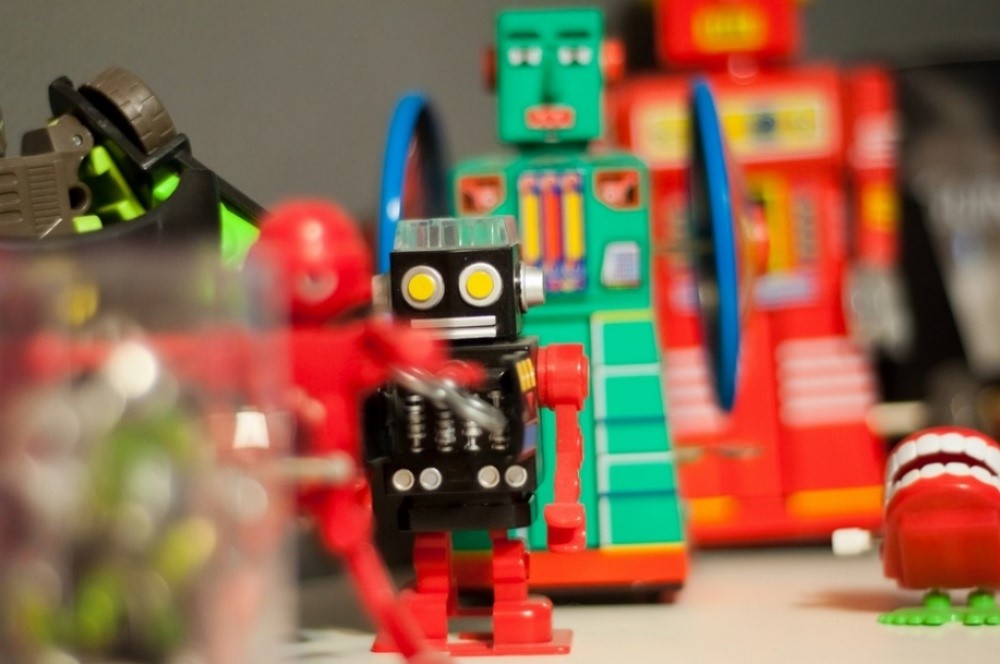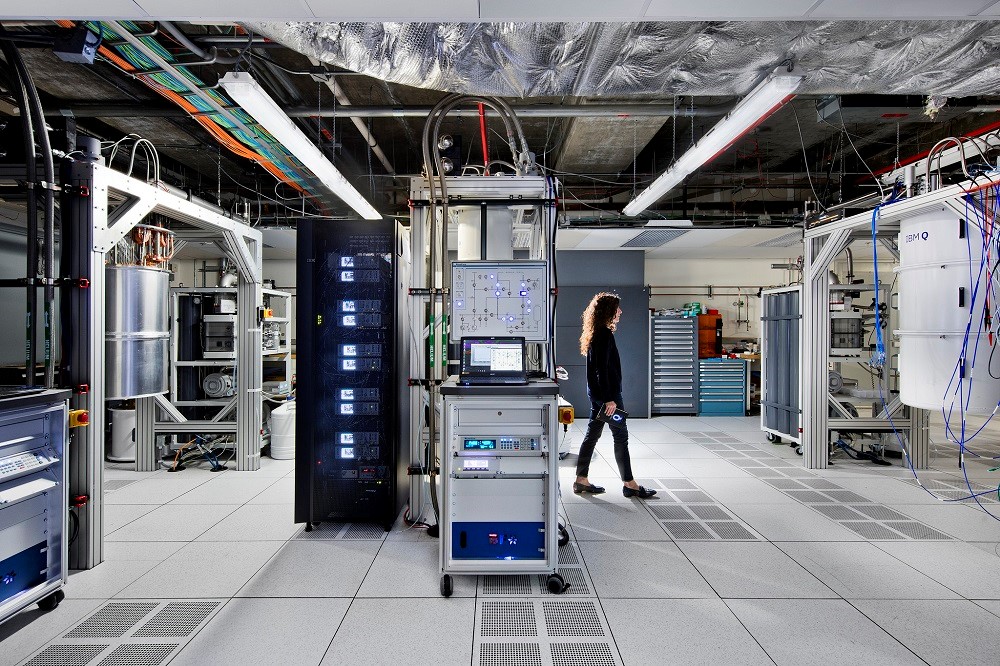How are things in the cloud, and what drives IaaS forward: discuss technological trends
Earlier we wrote about the trends of the IaaS market. Today we will dwell on a number of technologies that will act as drivers for the development of the cloud industry in the next few years. It will be about quantum computers, AI systems and some other solutions.

/ Photo by Alan O'Rourke CC
According to the evaluation Forrester Research, in 2018 the global market value of cloud services will grow from 146 billion dollars to 178 billion dollars. The average annual growth rate of the market will be 22%. At the same time, half of the companies in the world will use at least one cloud solution by the end of this year.
In the Russian market the situation is similar . According to analysts from the company J'son & Partners Consulting, the domestic market IaaS / PaaS will grow by 23-25% per year over the next 3-5 years.
A January survey conducted by Rightscale among thousands of IT specialists from various companies showed that 81% of organizations use hybrid cloud solutions. On average, one company "keeps in the cloud" about five different services. The results of the study also showed that the introduction of hybrid cloud infrastructure is a priority for 45% of companies.
For example, SEGA has become one of the organizations that turned to the hybrid infrastructure . During testing, games have to send a lot of build testers, working from different parts of the world. This process in SEGA took a lot of time and did not scale well - IT infrastructure resources were not enough to handle the sharp increase in the number of requests during individual development periods.
To solve the problem and additionally ensure the security of the data being sent, the company turned to a hybrid infrastructure. Now the uncompiled code of games is first transferred from on-premise servers to the public cloud, organized on the basis of VMware and Colt solutions. This accelerated the delivery of necessary files to testers and reduced the time for testing by 17%, which made it possible to create better products.
Now there is an active development of the Internet of things and the growing number of smart devices on the market. According to the assessment Statista number of IoT-gadgets will double by 2023. The development of the Internet of things will lead to an increase in the amount of data that will be processed in the cloud. Cisco predicts (Trend 5, chart 21 in the document ) that in 2018 alone the total amount of information in data centers will increase from 397 exabytes to 547 exabytes.
This would entail the need to expand already existing data centers and build new ones. This year alone, Google invested 150 and 500 million euros in expanding data centers in the Irish capital Dublin and Emshaven (Netherlands), respectively. Also the company is buildingthree new centers in Zurich.
At the same time, a growing amount of equipment in data centers (and an increase in the number of data centers themselves) will lead to the fact that companies will have to introduce new technologies to reduce costs for its maintenance. In particular, in the data center now about 40% of electricity consumed air conditioning systems. And when the "iron" a lot, it becomes unprofitable to cool with the help of standard air installations. For this reason, data center owners are introducing new solutions that increase cooling efficiency, such as liquid and immersion systems .
Also, companies are revising the architectural features of data centers in order to maximize the use of environmental opportunities for cooling machine rooms. For example, the company Yahoo builds data centers, the temperature in which is regulated by natural ventilation - these data centers look like chicken coops .
Hackers are beginning to use more powerful tools to conduct cyber attacks. Including based on artificial intelligence systems. Attackers use machine learning to detect vulnerabilities and find the most valuable data. The company Fortinet, dealing with information security issues, believes that “intelligent viruses” will be distributed through botnets from IoT devices.

/ photo Colin Payson CC
Another possible scenario is the use of machine learning for social engineering. Neural networks will help hackers automatically generate compelling phishing emails and posts for social networks.
One of the world's first machine learning attacks was discovered by Darktrace in an Indian company in 2017. The malicious program studied the behavior of users in the organization’s network and adjusted its behavior accordingly, trying to “merge” with the environment and remain imperceptible for anti-virus systems. And according to Darkole CEO Nicole Eagan, hacking cases using machine learning will increase over time.
Information security experts are convinced that if such hacker solutions become common, then only other artificial intelligence systems will be able to resist them. And 87% of companies are already using AI systems to enhance cybersecurity.
An example of intelligent "anti-virus" solutions is AI2, developed by researchers from MIT and PatternEx startup. She is able to identify suspicious behavior in the system and has already learned how to detect malicious activity with a probability of 85%.
Other systems can not only detect suspicious behaviors, but also block threats on their own. This is how Darktrace Antigena works . According to the software company, the program saves up to ten hours a week for each cybersecurity analyst.
Quantum computers will allow humanity to perform complex calculations and create complex models much faster. The technology is planned to be used in medicine, energy, financial sphere and other areas. For example, a quantum computer can be used to model complex chemical reactions when developing new drugs.
Some companies are already showing progress in creating quantum processors. 2000 qubit computers ( working on the principle of quantum annealing ) were created by D-Wave Systems. At the same time, D-Wave not only delivers solutions for its customers, but also offers to rent the power of a quantum machine for remote work.
The development of quantum computers are other companies. For example, a quantum chip was created at Intel - it has 49 qubits. And IBM has developed a 50-qubit quantum computer. At the same time, the company opened access for researchers and scientists to their “younger” 20-qubit systems. You can work with them thanks to the IBM Q. cloud platform

/ photo IBM Research CC
Other companies are working to simplify interaction with quantum computers. To do this, they write new libraries and programming languages. The Google AI Quantum team has developedplatform for implementing quantum algorithms Cirq. Using the tool, researchers can create the necessary models and test them in a simulator to later deploy to a real quantum computer.
And in Microsoft have developed a special language "quantum programming" Q #. The programs created with it can be run in an Azure-based simulator.
Morgan Stanley estimates that by 2027 the value of the quantum computer market will double, that is, to $ 10 billion. And as soon as the technology reaches its development and becomes available to a wider audience, this will change not only IaaS, but also other industries.
PS What else do we write in the First blog about corporate IaaS:
The main direction of our activity is the provision of cloud services:
Virtual Infrastructure (IaaS) | PCI DSS Hosting | Cloud FZ-152 | SAP Hosting | Virtual Storage | Cloud Encryption | Cloud storage

/ Photo by Alan O'Rourke CC
According to the evaluation Forrester Research, in 2018 the global market value of cloud services will grow from 146 billion dollars to 178 billion dollars. The average annual growth rate of the market will be 22%. At the same time, half of the companies in the world will use at least one cloud solution by the end of this year.
In the Russian market the situation is similar . According to analysts from the company J'son & Partners Consulting, the domestic market IaaS / PaaS will grow by 23-25% per year over the next 3-5 years.
Hybrid clouds are in the lead
A January survey conducted by Rightscale among thousands of IT specialists from various companies showed that 81% of organizations use hybrid cloud solutions. On average, one company "keeps in the cloud" about five different services. The results of the study also showed that the introduction of hybrid cloud infrastructure is a priority for 45% of companies.
For example, SEGA has become one of the organizations that turned to the hybrid infrastructure . During testing, games have to send a lot of build testers, working from different parts of the world. This process in SEGA took a lot of time and did not scale well - IT infrastructure resources were not enough to handle the sharp increase in the number of requests during individual development periods.
To solve the problem and additionally ensure the security of the data being sent, the company turned to a hybrid infrastructure. Now the uncompiled code of games is first transferred from on-premise servers to the public cloud, organized on the basis of VMware and Colt solutions. This accelerated the delivery of necessary files to testers and reduced the time for testing by 17%, which made it possible to create better products.
Energy efficiency is our everything
Now there is an active development of the Internet of things and the growing number of smart devices on the market. According to the assessment Statista number of IoT-gadgets will double by 2023. The development of the Internet of things will lead to an increase in the amount of data that will be processed in the cloud. Cisco predicts (Trend 5, chart 21 in the document ) that in 2018 alone the total amount of information in data centers will increase from 397 exabytes to 547 exabytes.
This would entail the need to expand already existing data centers and build new ones. This year alone, Google invested 150 and 500 million euros in expanding data centers in the Irish capital Dublin and Emshaven (Netherlands), respectively. Also the company is buildingthree new centers in Zurich.
At the same time, a growing amount of equipment in data centers (and an increase in the number of data centers themselves) will lead to the fact that companies will have to introduce new technologies to reduce costs for its maintenance. In particular, in the data center now about 40% of electricity consumed air conditioning systems. And when the "iron" a lot, it becomes unprofitable to cool with the help of standard air installations. For this reason, data center owners are introducing new solutions that increase cooling efficiency, such as liquid and immersion systems .
Also, companies are revising the architectural features of data centers in order to maximize the use of environmental opportunities for cooling machine rooms. For example, the company Yahoo builds data centers, the temperature in which is regulated by natural ventilation - these data centers look like chicken coops .
"Robots" on guard of the cloud
Hackers are beginning to use more powerful tools to conduct cyber attacks. Including based on artificial intelligence systems. Attackers use machine learning to detect vulnerabilities and find the most valuable data. The company Fortinet, dealing with information security issues, believes that “intelligent viruses” will be distributed through botnets from IoT devices.

/ photo Colin Payson CC
Another possible scenario is the use of machine learning for social engineering. Neural networks will help hackers automatically generate compelling phishing emails and posts for social networks.
One of the world's first machine learning attacks was discovered by Darktrace in an Indian company in 2017. The malicious program studied the behavior of users in the organization’s network and adjusted its behavior accordingly, trying to “merge” with the environment and remain imperceptible for anti-virus systems. And according to Darkole CEO Nicole Eagan, hacking cases using machine learning will increase over time.
Information security experts are convinced that if such hacker solutions become common, then only other artificial intelligence systems will be able to resist them. And 87% of companies are already using AI systems to enhance cybersecurity.
An example of intelligent "anti-virus" solutions is AI2, developed by researchers from MIT and PatternEx startup. She is able to identify suspicious behavior in the system and has already learned how to detect malicious activity with a probability of 85%.
Other systems can not only detect suspicious behaviors, but also block threats on their own. This is how Darktrace Antigena works . According to the software company, the program saves up to ten hours a week for each cybersecurity analyst.
Quantum will be closer to people
Quantum computers will allow humanity to perform complex calculations and create complex models much faster. The technology is planned to be used in medicine, energy, financial sphere and other areas. For example, a quantum computer can be used to model complex chemical reactions when developing new drugs.
Some companies are already showing progress in creating quantum processors. 2000 qubit computers ( working on the principle of quantum annealing ) were created by D-Wave Systems. At the same time, D-Wave not only delivers solutions for its customers, but also offers to rent the power of a quantum machine for remote work.
The development of quantum computers are other companies. For example, a quantum chip was created at Intel - it has 49 qubits. And IBM has developed a 50-qubit quantum computer. At the same time, the company opened access for researchers and scientists to their “younger” 20-qubit systems. You can work with them thanks to the IBM Q. cloud platform

/ photo IBM Research CC
Other companies are working to simplify interaction with quantum computers. To do this, they write new libraries and programming languages. The Google AI Quantum team has developedplatform for implementing quantum algorithms Cirq. Using the tool, researchers can create the necessary models and test them in a simulator to later deploy to a real quantum computer.
And in Microsoft have developed a special language "quantum programming" Q #. The programs created with it can be run in an Azure-based simulator.
Morgan Stanley estimates that by 2027 the value of the quantum computer market will double, that is, to $ 10 billion. And as soon as the technology reaches its development and becomes available to a wider audience, this will change not only IaaS, but also other industries.
PS What else do we write in the First blog about corporate IaaS:
- How to test disk system in the cloud
- NetApp from A to Z: a review of vendor technologies for modern storage systems
- Servers for SAP: Basic Platforms
The main direction of our activity is the provision of cloud services:
Virtual Infrastructure (IaaS) | PCI DSS Hosting | Cloud FZ-152 | SAP Hosting | Virtual Storage | Cloud Encryption | Cloud storage
